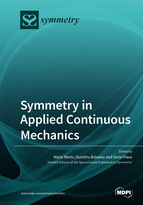Symmetry in Applied Continuous Mechanics
A special issue of Symmetry (ISSN 2073-8994). This special issue belongs to the section "Computer".
Deadline for manuscript submissions: closed (15 September 2019) | Viewed by 44173
Special Issue Editors
Interests: differential equations; partial differential equations; equations of evolution; integral equations; mixed initial-boundary value problems for PDE; termoelasticity; media with microstretch; environments goals; nonlinear problems
Special Issues, Collections and Topics in MDPI journals
2. Department of Mathematics, Cankaya University, Ankara 06530, Turkey
Interests: fractional dynamics; fractional differential equations; discrete mathematics; fractals; image processing; bio-informatics; mathematical biology; soliton theory; Lie symmetry; dynamic systems on time scales; computational complexity; the wavelet method
Special Issues, Collections and Topics in MDPI journals
Interests: mechanics; vibrations; elasticity; composite materials; analytical mechanics
Special Issues, Collections and Topics in MDPI journals
Special Issue Information
Dear Colleagues,
Engineering practice requires the use of structures containing identical components or parts, useful from several points of view: less information is needed to describe the system, design is made quicker and easier, components are made faster than a complex assembly, and finally the time to achieve the structure and the cost of manufacturing decreases. Also, the subsequent maintenance of the system becomes easier and cheaper.
This Special Issue is dedicated to this kind of mechanical structure, describing the properties and methods of analysis of these structures. Discrete or continuous structures in static and dynamic cases are considered.
Theoretical models, mathematical methods, numerical analysis of the systems, such as the finite element method and experimental methods are expected to be used in the researches. Machine building, automotive, aerospace and civil engineering are the main areas in which such applications appear, but they are found in most engineering fields.
Prof. Dr. Marin Marin
Prof. Dumitru Baleanu
Prof. Dr. Sorin Vlase
Guest Editors
Manuscript Submission Information
Manuscripts should be submitted online at www.mdpi.com by registering and logging in to this website. Once you are registered, click here to go to the submission form. Manuscripts can be submitted until the deadline. All submissions that pass pre-check are peer-reviewed. Accepted papers will be published continuously in the journal (as soon as accepted) and will be listed together on the special issue website. Research articles, review articles as well as short communications are invited. For planned papers, a title and short abstract (about 100 words) can be sent to the Editorial Office for announcement on this website.
Submitted manuscripts should not have been published previously, nor be under consideration for publication elsewhere (except conference proceedings papers). All manuscripts are thoroughly refereed through a single-blind peer-review process. A guide for authors and other relevant information for submission of manuscripts is available on the Instructions for Authors page. Symmetry is an international peer-reviewed open access monthly journal published by MDPI.
Please visit the Instructions for Authors page before submitting a manuscript. The Article Processing Charge (APC) for publication in this open access journal is 2400 CHF (Swiss Francs). Submitted papers should be well formatted and use good English. Authors may use MDPI's English editing service prior to publication or during author revisions.
Keywords
- Symmetry
- Skew symmetry
- identical parts
- automotive engineering
- structure
- numerical analysis
- modal analysis
- finite element method (FEM)
- aerospace engineering
- theoretical models
- elastic systems
- eigenvalue
- eigenmode
- experimental methods
- civil engineering








